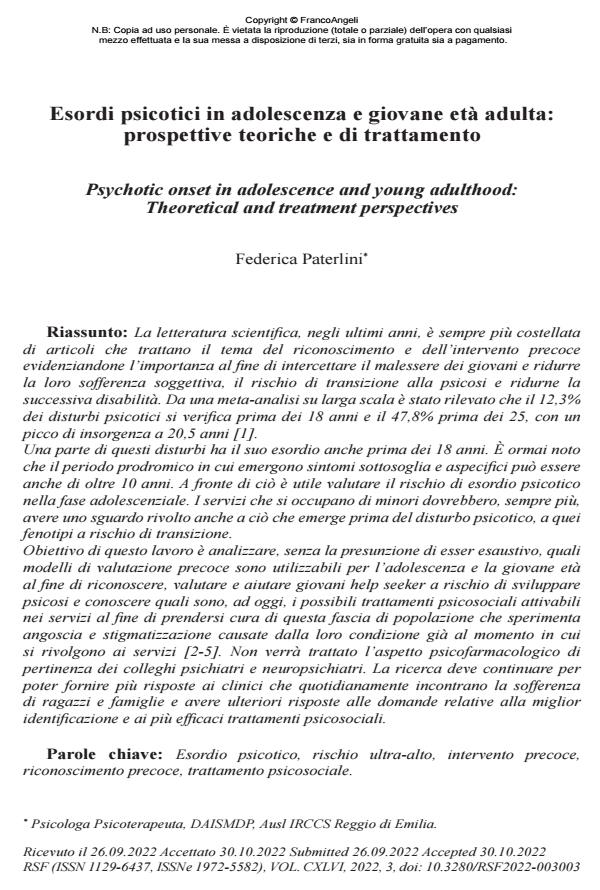Esordi psicotici in adolescenza e giovane età adulta: prospettive teoriche e di trattamento
Titolo Rivista RIVISTA SPERIMENTALE DI FRENIATRIA
Autori/Curatori Federica Paterlini
Anno di pubblicazione 2022 Fascicolo 2022/3
Lingua Italiano Numero pagine 30 P. 31-60 Dimensione file 259 KB
DOI 10.3280/RSF2022-003003
Il DOI è il codice a barre della proprietà intellettuale: per saperne di più
clicca qui
Qui sotto puoi vedere in anteprima la prima pagina di questo articolo.
Se questo articolo ti interessa, lo puoi acquistare (e scaricare in formato pdf) seguendo le facili indicazioni per acquistare il download credit. Acquista Download Credits per scaricare questo Articolo in formato PDF

FrancoAngeli è membro della Publishers International Linking Association, Inc (PILA)associazione indipendente e non profit per facilitare (attraverso i servizi tecnologici implementati da CrossRef.org) l’accesso degli studiosi ai contenuti digitali nelle pubblicazioni professionali e scientifiche
La letteratura scientifica, negli ultimi anni, è sempre più costellata di articoli che trattano il tema del riconoscimento e dell’intervento precoce evidenziandone l’importanza al fine di intercettare il malessere dei giovani e ridurre la loro sofferenza soggettiva, il rischio di transizione alla psicosi e ridurne la successiva disabilità. Da una meta-analisi su larga scala è stato rilevato che il 12,3% dei disturbi psicotici si verifica prima dei 18 anni e il 47,8% prima dei 25, con un picco di insorgenza a 20,5 anni [1]. Una parte di questi disturbi ha il suo esordio anche prima dei 18 anni. È ormai noto che il periodo prodromico in cui emergono sintomi sottosoglia e aspecifici può essere anche di oltre 10 anni. A fronte di ciò è utile valutare il rischio di esordio psicotico nella fase adolescenziale. I servizi che si occupano di minori dovrebbero, sempre più, avere uno sguardo rivolto anche a ciò che emerge prima del disturbo psicotico, a quei fenotipi a rischio di transizione. Obiettivo di questo lavoro è analizzare, senza la presunzione di esser esaustivo, quali modelli di valutazione precoce sono utilizzabili per l’adolescenza e la giovane età al fine di riconoscere, valutare e aiutare giovani help seeker a rischio di sviluppare psicosi e conoscere quali sono, ad oggi, i possibili trattamenti psicosociali attivabili nei servizi al fine di prendersi cura di questa fascia di popolazione che sperimenta angoscia e stigmatizzazione causate dalla loro condizione già al momento in cui si rivolgono ai servizi [2-5]. Non verrà trattato l’aspetto psicofarmacologico di pertinenza dei colleghi psichiatri e neuropsichiatri. La ricerca deve continuare per poter fornire più risposte ai clinici che quotidianamente incontrano la sofferenza di ragazzi e famiglie e avere ulteriori risposte alle domande relative alla miglior identificazione e ai più efficaci trattamenti psicosociali.
Parole chiave:Esordio psicotico, rischio ultra-alto, intervento precoce, riconoscimento precoce, trattamento psicosociale.
Federica Paterlini, Esordi psicotici in adolescenza e giovane età adulta: prospettive teoriche e di trattamento in "RIVISTA SPERIMENTALE DI FRENIATRIA" 3/2022, pp 31-60, DOI: 10.3280/RSF2022-003003